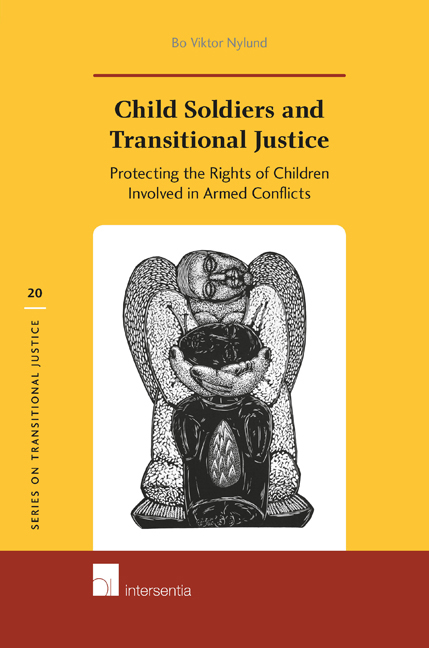 Child Soldiers and Transitional Justice
Child Soldiers and Transitional Justice Book contents
- Frontmatter
- Acknowledgements
- About the Author
- Contents
- List of Abbreviations
- Chapter 1 Objective, Scope, and Transitional Justice as an Analytical Framework
- Chapter 2 Child Recruitment and the Rule of Law: International Law and the Prohibition against Recruiting and Using Children to Take Direct Part in Hostilities
- Chapter 3 Child Recruitment and Criminal Justice: the Lubanga Case
- Chapter 4 Child Recruitment and Historical Justice: the Security Council Mechanism on Monitoring and Reporting
- Chapter 5 Child Recruitment and Reparatory Justice: Recovery and Reintegration of War-Affected Children
- Chapter 6 Child Recruitment and Institutional Justice
- Chapter 7 Children Involved in Armed Conflict and Participatory Justice: Balancing Rights and Responsibilities
- Chapter 8 Conclusions: Transitional Justice and the Potential for Stronger Protection of the Rights of Children Involved in Armed Conflicts
- Annexes
- Bibliography
Chapter 5 - Child Recruitment and Reparatory Justice: Recovery and Reintegration of War-Affected Children
Published online by Cambridge University Press: 12 December 2017
- Frontmatter
- Acknowledgements
- About the Author
- Contents
- List of Abbreviations
- Chapter 1 Objective, Scope, and Transitional Justice as an Analytical Framework
- Chapter 2 Child Recruitment and the Rule of Law: International Law and the Prohibition against Recruiting and Using Children to Take Direct Part in Hostilities
- Chapter 3 Child Recruitment and Criminal Justice: the Lubanga Case
- Chapter 4 Child Recruitment and Historical Justice: the Security Council Mechanism on Monitoring and Reporting
- Chapter 5 Child Recruitment and Reparatory Justice: Recovery and Reintegration of War-Affected Children
- Chapter 6 Child Recruitment and Institutional Justice
- Chapter 7 Children Involved in Armed Conflict and Participatory Justice: Balancing Rights and Responsibilities
- Chapter 8 Conclusions: Transitional Justice and the Potential for Stronger Protection of the Rights of Children Involved in Armed Conflicts
- Annexes
- Bibliography
Summary
“When we first came back, the people did not want us. But now it is OK. Now it is good. They like the projects we are doing for the village.”
INTRODUCTION
Reparatory justice is an integral part of transitional justice and builds on the obligation of states to make restitution whenever international legal obligations have been violated. The Basic Principles and Guidelines on the Right to a Remedy and Reparation, adopted by the UN General Assembly in 2006, form the basis of what today is considered a framework for reparations – defining that victims of human rights and humanitarian law violations have the right to “adequate, effective, prompt and appropriate remedies, including reparation.”
In addition:
Restitution should, whenever possible, restore the victim to the original situation before the gross violations of international human rights law or serious violations of international humanitarian law occurred. Restitution includes, as appropriate: restoration of liberty, enjoyment of human rights, identity, family life and citizenship, return to one's place of residence, restoration of employment and return of property.
The Basic Principles and Guidelines further state that compensation should consider the circumstances for each case and be provided in proportion to the severity of the violation.
Reparatory justice includes many dimensions and forms: reparations, services, damages, remedies, redress, restitution, compensation, rehabilitation, official apology, tribute. In transitional contexts, reparatory justice enables recognition of individual rights violations and the harm that followed, and the fact that someone did wrong, in addition to a commitment for non-repetition of the crime. This element looks back at what the violations were, and even if it is not the same actor who repairs, the obligation remains. It also looks forward in a political and transitional sense, repairing so as to be able to move forward.
Key legal questions that are covered in this chapter include:
– What does reparatory justice mean in the context of recruitment and use of children in armed conflicts? How can we ensure that reparations are in the best interests of the child?
– What legal protection is accorded to children ensuring that this element of transitional justice is accorded the necessary importance?
– What lessons have been learned from reparatory justice processes relevant to the recruitment and use of children, and how can those inform how this element fits into a broader transitional justice approach?
– Who repairs?
- Type
- Chapter
- Information
- Child Soldiers and Transitional JusticeProtecting the Rights of Children Involved in Armed Conflicts, pp. 135 - 162Publisher: IntersentiaPrint publication year: 2016


